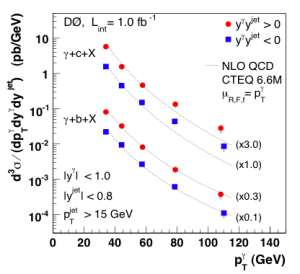Does the Proton Contain Charm Quarks?!?
January 18, 2009 at 3:10 pm 1 comment
The mass of the proton is 0.938 GeV, and the mass of a single charm quark is something like 1.3 GeV, so the answer would appear to be: obviously not. In the wonderful world of quantum mechanics, and perturbative QCD, the answer is not so obvious.
The question is normally phrased: Is there an intrinsic component of charm in the nucleon? Recently the D0 Collaboration posted a measurement which provides a partial answer. The paper is Measurement of photon+b+X and photon+c+X cross sections… (arXiv:0901.0739). They used advanced data analysis tools to identify photons and jets containing heavy flavor, and then measured differential cross sections using 1 fb-1 of Run II Tevatron data. These measurements allows a test of a calculation by Tzvetalina Stavreva and Jeff Owens based on “normal” PDFs (parton distribution functions) and on two alternative sets with intrinsic charm components.
To make this measurement, the authors needed a sample of events with a single, well-identified high-pT photon, and a bottom or charm jet. They needed the rapidity and transverse momentum of both. They present their results as a function of the photon pT, for the cases when the photon and the jet are on the same end of the detector or on opposite ends (as defined by a plane perpendicular to the beam and passing through the event vertex). For each pT bin, they must ascertain the number of b-jet, c-jet, and light quark jets, and they do this by fitting three templates to the distribution of an artificial neural network variable. A nice example is shown below.

fit three templates to observed distribution of gamma artificial network output variable
This fit is repeated for several pT bins, twice, depending on the relative sign of the photon and jet rapidity:

measured cross sections compared to theoretical calculation
The measured cross section confirms the preliminary calculations of Stavreva and Owens for photon+b-jets, but for charm jets the agreement is less good. This is easy to see from the plots of the ratio of the measured cross sections to the prediction:

ratio of measured cross sections to the predictions
In particular, the data show a charm contribution much larger than predicted at high jet pT (bottom two plots). In the figure, the red dash-dotted lines show the level of enhancement predicted when a PDF with intrinsic charm is used in the calculation. The intrinsic charm does indeed predict larger cross sections at high pT, as one would expect, but not large enough.
This measurement presents an interesting puzzle for jet production in hadron colliders. Can one say that this confirms the existence of an intrinsic charm component to the nucleon? I would not say that this one measurement suffices, but it is suggestive. In any case, more measurements would be welcome.
Entry filed under: Particle Physics.
1. Ashley Worman-Hess | February 10, 2009 at 10:13 am
Ashley Worman-Hess | February 10, 2009 at 10:13 am
Please email me – I almost had a heart attack when I saw PhD Mike Schmidt online Obit!!!